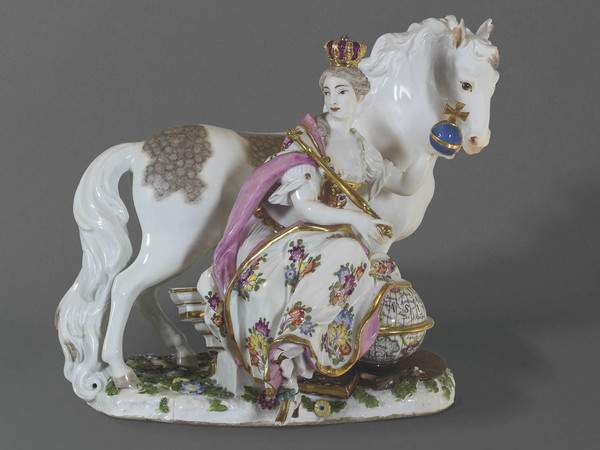Parma, the precious porcelain of the dukes is on display at the palace of Colorno
From the Quirinal Palace, for the exhibition The Porcelain of the Dukes of Parma. Masterpieces from the Great Manufactures of 18th-century Europe, exceptionally returning to the Reggia di Colorno are the priceless porcelains that Louise Elizabeth of France and her consort Philip of Bourbon used here for ducal receptions now available for state receptions of the Presidency of the Republic.
Other, and equally valuable, porcelains from the manufactures of Meissen, Sèvres, Vincennes, Chantilly, Doccia and Capodimonte, also belonging to what was the ducal heritage, will also temporarily return “home” from the Uffizi Galleries, the Museo della Villa Medicea di Poggio di Caiano, and the Royal Museums of Turin, accompanied by documents granted by theState Archives.
Reunited for the first time since the dispersion of the art treasures of the Parma royal palaces that began in 1859, when the Duchy of Parma and Piacenza was cancelled to be, the following year, incorporated into the new Kingdom of Italy. As a result of this, the heritage of what had for centuries been one of Europe’s most refined and international courts passed to the House of Savoy. The furnishings, passing through Turin and Florence, came in good part to the Quirinal Palace, to furnish the palace of the Savoy family, later to become the “home” of the Presidents of the Italian Republic.
It is work conducted in the Archives that has enabled Giovanni Godi and the group of experts overseeing the exhibition to identify the locations where the Parma treasures were “placed,” bringing them back home if only for the time of the exhibition.
These refined works of the highest quality highlight how taste at the court of the Dukes of Parma was shaped in full accord with French models developed in the 18th century, when decorative richness and a desire for ostentation accompanied the setting of tables on the old continent.
The Dukes’ passion for porcelain was indeed absolute. Louise Elizabeth, “Babette” as her father, Louis XV ruler of France, called her, was literally enchanted by the exotic charm of this compact, lustrous and light material, capable of bringing to life objects with refined lines that helped identify the social status of those who owned them. On her frequent trips to Versailles, she did not neglect to make purchases at her father’s expense both to endow what she called her “modest” residence with adequate fashionable crockery and to make gifts for her husband (“cher Pippo”), who showed that he shared with her the pleasure of precious porcelain.
Thus the small Duchy acquired the best of the production of all the most prestigious European manufactures that the Duchess personally sought out and commissioned, as confirmed by the numerous letters on display. There were porcelain objects in their residences: fine tableware, coffee sets, figurines, ice cream cups and curious objects signed by Meissen, Sèvres, Vincennes, Chantilly, Doccia and Capodimonte.
The exhibition will be on display until Sept. 19 on the main floor of the Reggia, following a subdivision by theme. Of note, in the same rooms, which until a few years ago were bare, part of the original furnishings, recovered from the post-unification diaspora, have returned.
Alongside the porcelain will be on display portraits, letters and documents related to the purchases of the Duchess and Prime Minister François Guillaume Leon Du Tillot, drawings of furniture and furnishings designed by Ennemond Alexandre Petitot, plans of the Ducal Palace of Colorno, books and engravings of feasts and weddings of the Dukes of Parma, as well as cookbooks in use at the kitchens of the 18th century.
The exhibition is the result of a collaboration between the Province of Parma, the Uffizi Galleries of Florence and Antea and is sponsored by the Province of Parma, the City of Parma, the City of Colorno and the Monumental Complex of the Pilotta in Parma, the State Archives and the Soprintendenza Archeologica belle arti e Paesaggi for Parma and Piacenza. The exhibits come from Palazzo del Quirinale, Complesso Monumentale della Pilotta in Parma, Uffizi Galleries, Museo della Villa Medicea di Poggio a Caiano, Royal Museums of Turin, Cariparma Foundation, Parma State Archives and private collectors.
For all information you can visit the official website of the Reggia di Colorno.
Pictured: Meissen workshop, Allegory of Europe, porcelain, 25.5 cm.
 |
| Parma, the precious porcelain of the dukes is on display at the palace of Colorno |
Warning: the translation into English of the original Italian article was created using automatic tools. We undertake to review all articles, but we do not guarantee the total absence of inaccuracies in the translation due to the program. You can find the original by clicking on the ITA button. If you find any mistake,please contact us.





























